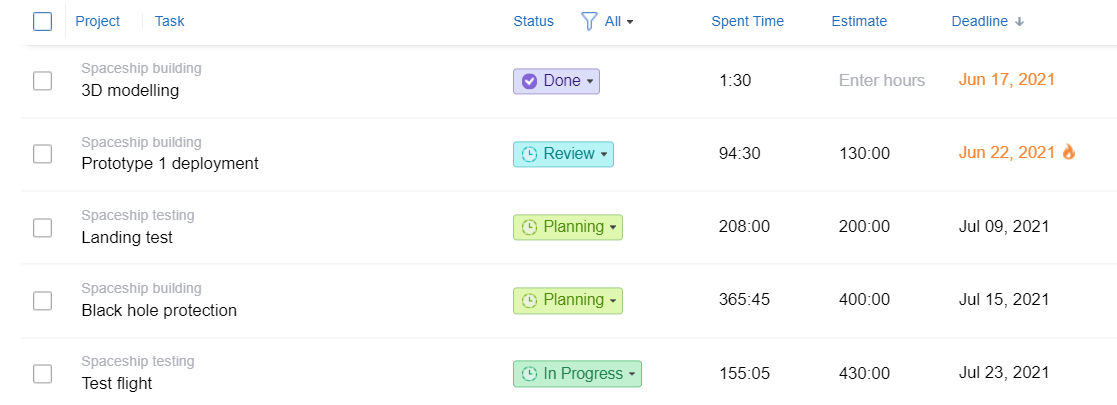
When it comes to employee hours, the usual Monday through Friday 9-to-5 has been the standard for what seems like forever. And while such a fixed schedule is pretty much universal even today, more and more employees prefer to work in companies with flexible work arrangements.
A lot of us have medical issues, families and other aspects of our personal lives that often conflict with our fixed work schedules. One solution that has been gaining a lot of traction with employers in the recent years is flex time.
But what is flex time exactly?
In this article, we are going to discuss the concept of flex time, discuss its benefits and answer some of the most popular questions on how it actually works. Plus, we’ll explain how to manage and track employees’ flexible hours the best way possible. However, if you’re ready to jump on this task without any further ado, start to use our multifunctional time tracker, actiTIME, for free during a 30-day online trial.
Click here to sign up!
What Is Flex Time?
Flex time is a flexible work hours policy where employees are allowed to choose when their workday starts and ends, as long as they achieve the daily, weekly or monthly hours set by the employer. There are several variations, but the core principle is the same – to provide employees with more freedom and flexibility in making their own work schedule.
Available Flex Time Options
There are quite a few options available to you in terms of how you can approach flex time in your company:
-
Job sharing.
One of the oldest ones is job sharing, where two part-time employees work half hours both comprising one full-time employee. In order to make this one work, all tasks, roles and responsibilities need to be well-coordinated and clearly communicated to ensure optimal productivity.
-
Flexible schedule.
A second option simply allows employees to work different hours, which usually means coming to work earlier (or later) than their colleagues. For example, instead of working 9 AM to 5 PM, employees on flex time can work 8 AM to 4 PM, or 11 AM to 7 PM.
-
Flexible workweek.
Another option allows employees to alternate between working a four-day week and then a five-day week. Or they can work ten days straight and then have four consecutive days off. Or, they can work four ten-hour days and then have three days off. The possibilities are limited only by what you think can work for your company.
-
Comp time.
In companies with busy seasons, like accounting firms, for instance, employees can work a lot longer hours than the usual 40 per week during peak periods. But they’re not paid overtime on those extra hours. Instead, they can use this “comp time” to leave early on some days or even take a day off to balance their hours out.
-
Remote work.
And if the kind of work employees do does not require them to be physically present at the workplace at all times, or if their work environment is too small or noisy, they can work remotely, from the comfort of their home or their favorite coffee shop.
3 Flex Time Benefits for Employees
-
Improved work-life balance.
Flexible work arrangements provide employees a greater chance to attend to personal needs without compromising their professional performance. When the work schedule is flexible, you don’t have to sit at the desk for eight hours in a row and then catch up with personal stuff in the remaining waking hours. Instead, you can switch between professional and personal activities throughout the day, take better care of your kids, spend more time with your friends, go on short walks in a nearby park, read books and engage in personal projects if you like. Flex time allows individuals to combine all those important things with their regular work routines in a more productive and delightful way.
-
Better health.
Stressful commuting, sitting in uncomfortable office spaces and committing to inflexible work schedules – these three things take a massive toll on employees’ health. By adopting flex time in your company, you will help your staff members avoid everyday traffic jams and work in nicer environments – at home. Having a chance to work from home at least one day a week can make a huge difference for exhausted employees. It lets them re-energize, become more relaxed and take better care of their mental and physical well-being.
-
More opportunities for development.
All in all, under flexible work arrangements, it’s much easier for employees to realize their full potential and advance in the career. With more time at hand, self-improvement becomes less challenging. Schedule flexibility also means you can always find time to attend classes or study on your own if you want. Besides, when you stay motivated and show excellent performance results at work (thanks to flex time to a large degree), you increase your chances for recognition and promotion – a win-win situation for employers and their staff members alike.
5 Flex Time Benefits for Employers
You don’t really have to offer flex time to your workers, but it would be a mistake not to try. Here are a few valid reasons why you should give it a go:
-
Higher employee satisfaction and retention.
Since flexible working provides your employees with more time to attend to their personal needs, they will be less frustrated about their lives and become happier with their workplace. Additionally, offering flex time to employees is a good way to express your appreciation and show how much you trust them. This, in turn, will help you build greater employee loyalty and form longer-term relationships with your team members.
-
An opportunity to attract top talent.
The interest in flexible work arrangements is growing. More and more people are deliberately looking for employers that offer some form of flexibility in terms of scheduling and telecommuting. So, by giving them what they want, you will be able to attract a higher number of promising candidates to your company. And if that happens, you will get a superior chance to find and hire the best talents.
-
Safer work environment.
Greater workplace flexibility means that fewer employees are physically present at the office at the same time. And as the globally shared experience during the 2020 pandemic showed, uncrowded places are good for both the public and individual health. Thus, by allowing your team members to come to work at different hours or even work from home, you can decrease the risk of infection and make the workplace safer for everyone.
-
Improved productivity.
Gartner 2021 Digital Worker Experience Survey revealed that flex time helped increase productivity in 43% of respondents (i.e., about 4,300 individuals). And another 30% reported that they managed to get more things done just by saving time on the commute. Based on this, letting your team members work flexible hours or from home is an excellent way to boost organizational performance. Besides, you should remember that flex time is linked to lower stress and higher satisfaction among employees, and people in good spirits always tend to be more motivated and productive.
-
Greater cost-efficiency.
Flex time allows you to save money in many ways. If at least half of your team starts to work from home, you can opt for smaller office space and invest less money in rent. Fewer people at the workplace also means you can consume less energy and stop purchasing that many office supplies. In addition, flex time helps you decrease costs inherent in high staff turnover. If employees remain committed to the workplace and don’t quit frequently, there’s no need to spend extra money on new staff recruitment, onboarding and training. Instead, you may use it to develop and improve what you already have.
There are more ways to track and save time than you think. Pass our quiz to learn more.
How to Introduce Flex Time into Your Team
To get the best out of flex time, follow these steps:
-
Make sure that your goals for flex time employees are absolutely clear.
They need to be specific and measurable. Agree on the scope of work, the deadline by which it needs to be delivered, and on how the end result will be communicated, so there’s absolutely no ambiguity involved.
-
Ensure that everyone on flex time knows their exact role in the company.
Every person must know their own responsibilities, as well as those of other employees. Every person must know exactly who does what and who answers to whom. Otherwise you might end up dealing with a lot of confusion and blame being thrown around.
-
Set some guidelines regarding the frequency and mode of communication that you require from your flex time folk.
The amount of control and contact that you want from your employees is entirely up to you and your management style. Some bosses are fine with a phone call or an email, others demand a regular face-to-face meeting. Figure out where you are on that spectrum, and let your employees know.
-
Establish regular hours for your employees working remotely.
Make sure they outline a specific time when they’ll be available via phone or email, and set a period when they need to be physically present at the business location for a certain amount of time. This will make scheduling meetings a lot more convenient, and also have everyone under the same roof which is great for team morale and bonding.
Keeping Track of Flex Time
Tracking flexible hours may sound like a real headache, but it’s really not that difficult. There are literally dozens of different electronic timesheet solutions available. They allow you to easily capture your employee’s work hours (flexible or otherwise), and present that information to you in a digestible and easy-to-read format.
actiTIME has a robust reporting feature that will readily provide you with a comprehensive picture of your employees’ flex time. It will show you how their reported time stacks up against their daily, weekly or monthly hours.
Here’s how actiTIME can assist you in managing different types of flex time:
- Job sharing | Responsibility sharing means you need to collaborate and stay aware of each others’ progress, which is effortless to do with such actiTIME features as task comments, progress statuses and visual estimate tracking. They enable you to share critical project information with colleagues, monitor ongoing progress statuses for different tasks, and see which portion of the total time estimate is already used on work. The best part: you can access these features right from your timesheet. Alternatively, you can get a more detailed view of task estimates, statuses and other info via the list of tasks.
- Flexible schedule | actiTIME auto-calculates and depicts working time totals at the bottom of users’ timesheets. Thus, even if your employees work a different number of hours every day, they will always know how much more they need to spend on tasks to hit the 40-hour workweek target. Meanwhile, managers can check their teams’ daily time tracking results via charts, reports and real-time widgets that give a greater sense of control over flexible schedules.
- Comp time | In a similar way, actiTIME captures employees’ overtime hours automatically and presents the totals either at the bottom of the timesheets (for employees’ personal use) or in detailed overtime reports (for manager’s use). Then, you can apply these overtime data to adjust your team members’ PTO balances and reward them with more days off for hard work.
- Remote work | actiTIME has a mobile app that allows remote employees to track working hours anytime and anywhere (even in the offline mode). Besides, actiTIME can be integrated with actiPLANS, a smart absence management solution that makes flex time management a breeze. It helps you review colleagues’ availability on the corporate schedule and gives users tools to promptly notify their managers about any changes in personal work schedules. All in all, with the help of this valuable actiTIME integration, it’s super easy to keep flex time in check.

Flex Time and Overtime
When it comes to overtime, there is no real difference between employees working regular hours and their flex time counterparts. The same rules still apply – if a person works more hours than what they’re required over the course of a single workweek (or a single day, in the case of California), they must be compensated for that extra time.
Offering flex time to your employees could allow them to better balance their lives around work without sacrificing productivity. Being able to work full time without having to worry about any personal issues allows them to focus their efforts on the job. However, flex time is not a perfect solution for every business, so be sure to keep all the pros and cons of flex time in mind if you’re thinking about giving it a shot.
















































